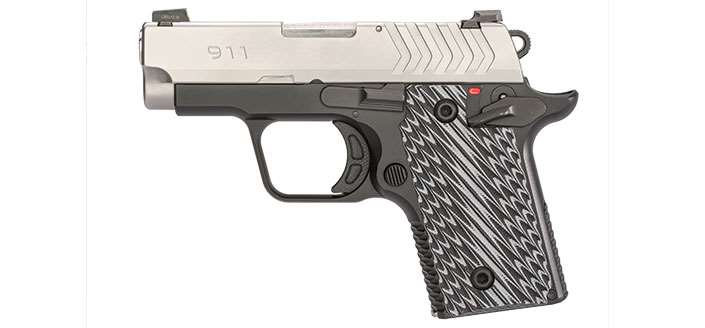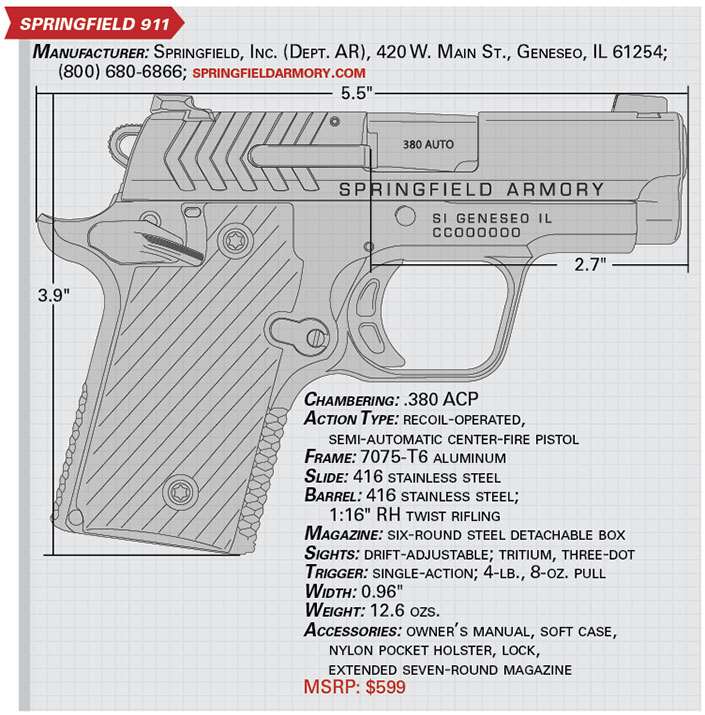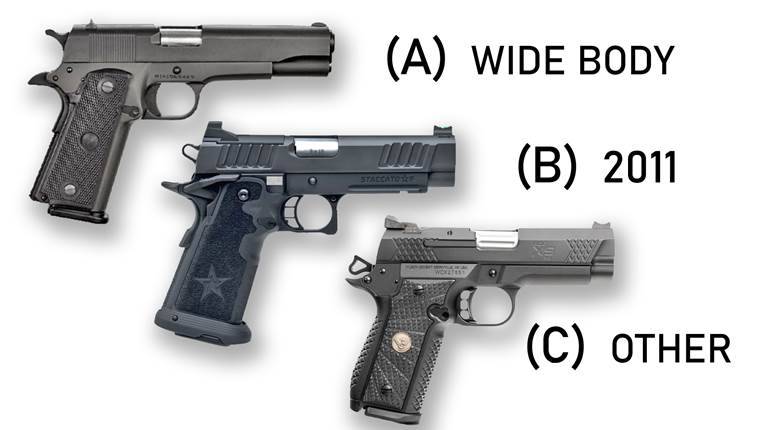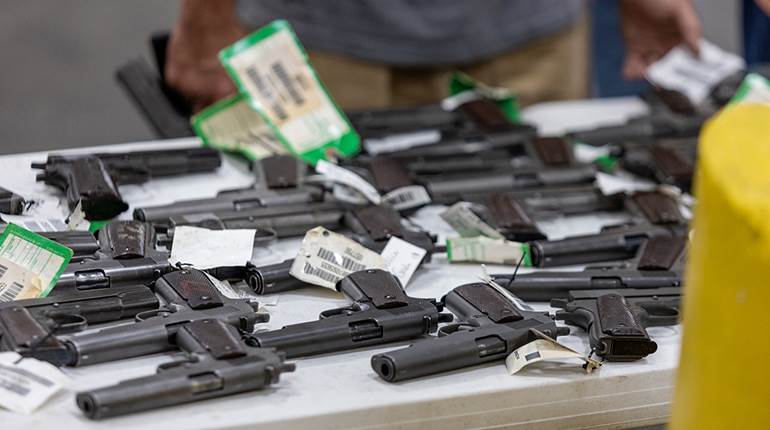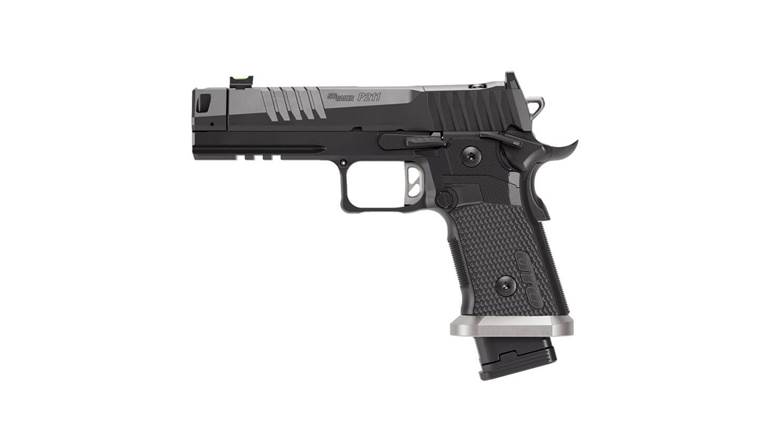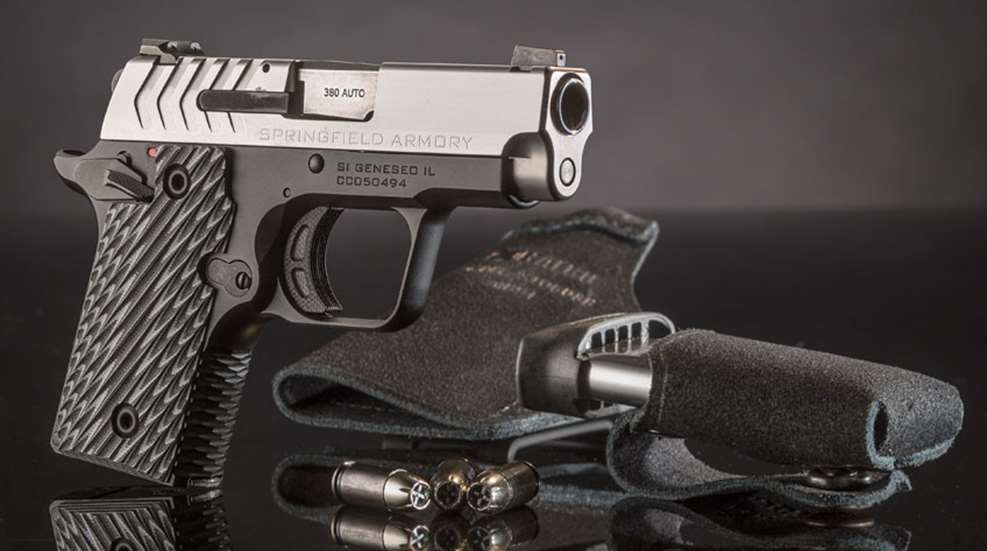
Galco’s steerhide Stow-N-Go holster and Carry Lite Mag Carrier, along with Browning’s BXP X-Point Personal Defense ammunition, work in concert with Springfield’s 911 to provide the concealed carrier with a discreet yet effective package.
Folks sometimes buy pocket pistols based on size alone, and too often find out that shooting them is difficult and unpleasant. Their short barrels necessitate strong recoil springs that make slide manipulation a chore, and their petite size results in a compromised shooting grip that produces less than satisfactory results. Terrible sights and heavy triggers combined with an obnoxious bark and bite make for miserable range sessions, and the end result is a gun that is left at home instead of carried on the owner at all times so as to be ready when needed.
Springfield Armory’s new 911 semi-automatic .380 ACP pistol possesses so many “big-gun” features that it just may be the remedy to the micro-compact pistol’s maladies. Built with a priority on size and weight, Springfield Armory’s engineers also placed an emphasis on ergonomics in an effort to make the 911 shoot like a much bigger gun.
“We wanted to make the new gun as comfortable as possible to shoot. We want people to go to the range and practice, and that meant the 911 had to resolve a number of common complaints peculiar to pocket pistols. We had to make the gun easy to rack, and we needed to have usable sights and a crisp trigger,” said Dennis Reese, owner and CEO of Springfield Armory. “We also made it impossible for the shooter to experience slide and hammer bite. We kept the comfortable 1911 grip angle and placed all the controls in the original Browning-inspired locations so it’s an intuitive gun to shoot if you’ve had 1911 experience.”
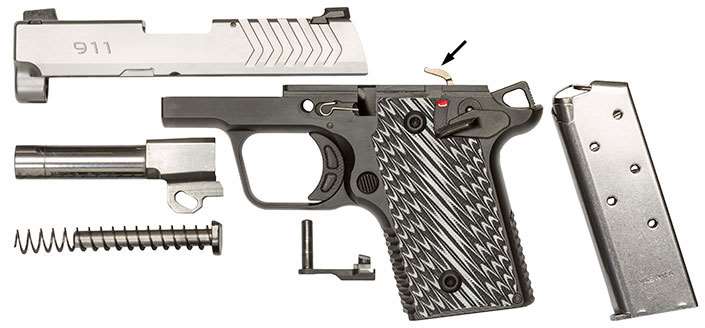
Springfield Armory’s 911 is a single-action, semi-automatic chambered for the .380 ACP cartridge that fires from a locked breech. Standing just 4" tall and with an overall length of 5.5", the 911’s diminutive dimensions make it a very concealable gun. It weighs just 12.6 ozs. empty, making it a gun that is effortless to carry. The pistol marks the company’s first .380 ACP-chambered offering, and Reese said the time was right for Springfield’s catalog to expand to include this small, but capable, chambering.
“The popularity of the .380 cartridge made me realize that it was time for Springfield Armory to come out with one. The current .380 cartridges do not perform like those of 20 to 30 years ago; it’s now a real cartridge, and I think it appeals to folks who want a really small pocket gun,” he said.
Despite its size, Springfield engineers did a great job of making this tiny gun “shootable.” It possesses a comfortable grip angle, and the trigger guard is undercut where it meets the frame, allowing shooters to get as high a hold as possible. To prevent hammer bite, Springfield has incorporated a fixed beavertail that encompasses the rear of the hammer when at full-cock, making it impossible for even the fleshiest of hands to be bitten by the slide or hammer. The gun’s frontstrap is machined with what Springfield Armory calls Octo-Grip texture, and this pattern is repeated on the G10 mainspring housing made by Hogue. Its stock panels, also a Hogue G10 product, are grooved to provide the shooter with a secure firing grip. By the way, measured at the grips—the gun’s widest point—the 911 measures just 0.96" thick. Its slide, measured at its widest point, is just 0.80".
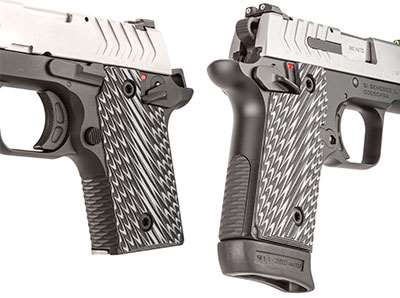
Although the 911 is modeled after the M1911 pistol, it is not a miniature replication; its barrel and internal lockwork are different. An example of this difference are the gun’s bilateral thumb safeties. Unlike the M1911, the 911 can be loaded and unloaded with the manual safety on. But the gun’s slide stop, magazine release and thumb safety are all in the familiar locations, and users with M1911 experience will have no problem running the 911. Like the M1911, the smaller gun can be carried “cocked and locked,” with the chamber loaded, hammer back and manual thumb safety applied.
Springfield Armory machines the 911’s frame from 7075-T6 aluminum, and this makes the little gun incredibly light. Its barrel and slide are machined from 416R stainless steel. The 911’s barrel measures just 2.7" in length, and uses its breechblock to lock into the slide’s ejection port. As the barrel recoils, a kidney-shaped cutout on the lower barrel lug impinges on the slide stop pin, pulling the rear of the barrel out of battery and allowing the slide to cycle after a shot is fired. Springfield uses an external extractor on the 911, and the handgun also has a loaded-chamber indicator at the top of the slide. To prevent inertia-type discharges, a passive firing pin safety is incorporated into the 911’s slide. Deep chevron-style cocking serrations make charging the 911’s chamber easy. The gun uses a single, flat-wire recoil spring, and I found that very little effort was required to manually cycle the slide.
The fit and finish of the 911 is exemplary. Its slide-to-frame fit is wobble-free, and neither the frame nor slide exhibit any tooling marks. Parts such as the thumb safeties, magazine release, extractor and loaded-chamber indicator are well-fit and without slop. Even the sight dovetails are precise and showed no daylight between the cut and sight. All of the gun’s sharp edges have been removed, and there is nothing that might cut its user or an expensive leather holster.
One feature that makes the 911 such a great little shooter is its trigger. My test sample’s trigger broke at a very crisp 4 lbs., 8 ozs., and it has a very positive reset, which is critical for shooting quickly. Unlike the M1911, the 911’s trigger pivots, and Hogue manufactures the trigger shoe for Springfield from lightweight, but tough, G10 material.
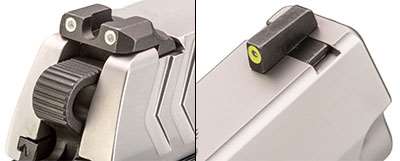
Another huge factor in the gun’s shootability is its sights. Though the sights are low-profile in design, they are large enough to shoot the little gun really well. The front sight is an Ameriglo Pro-Glo green tritium night sight with a bright yellow luminescent circle around it that draws the eye’s focus, even in bright light. The rear sight possesses two tritium lamps surrounded by white luminescent rings. This sight combination makes the 911 effective in both low-light and bright-light scenarios. A U-shaped notch is used for quick sight alignment, and the front surface of the rear sight has a ledge designed for tactical one-handed charging of the chamber.
“It’s a pocket pistol, so it doesn’t appeal to just women or seniors; it is basically attractive to anyone who wants an extremely reliable and accurate, pleasant to shoot and pleasant to pack .380,” Reese said. “The fact that you have something so small yet so easy to shoot and a joy to train with, gives the 911 very broad desirability. It’s a serious handgun for all demographics.”
Disassembly of the 911 is easy and doesn’t require any special tools. Start by removing the magazine and clearing the chamber. Manually lock the slide to the rear, using the slide stop, and visually inspect the chamber to ensure the gun is completely unloaded. Lower the slide to its “in battery” position and then retract it until the half-moon disassembly slide cut-out is directly over the slide stop tab, and then push the slide stop out of the frame from right to left. Now ease the slide and barrel assembly forward and off the frame. The full-length recoil spring guide rod and spring can now be removed from the slide, followed by the barrel. This is as far as you should ever need to disassemble the 911 for routine cleaning and lubrication. Reassembly is a little trickier because of the 911’s frame-mounted pivoting ejector. When placing the slide and barrel assembly back onto the frame’s rails, the ejector must be manually pushed down for the slide to go into place. Those who don’t read the instructions and try to force the slide back onto the frame will likely be returning their gun to the factory for repair. With the slide back on the frame, the slide stop can be re-inserted, and reassembly is complete.
Given the gun’s excellent trigger, and despite its short barrel and sight radius, we decided to test its accuracy at 15 yds.—even though 7 yds. is the standard protocol for such small pistols. Shooting from a stable bench and utilizing a Millett BenchMaster for support, my average group size for all of the loads tested was just 1.27" which is phenomenal for a micro-compact at this range. There’s no doubt the 911 possesses a great deal of mechanical accuracy, but its crisp trigger and excellent sights made shooting the little gun to its potential much easier.
Springfield Armory ships the 911 with a six-round, flush-fit magazine and a seven-round, extended magazine. Of course, the flush-fit magazine will offer the user the best concealability, and, using it, I was able to get two fingers on the short frontstrap with my little finger curling under the bottom of the grip. But using the extended magazine made the gun feel completely different and allowed me to get all three fingers on the frontstrap and magazine extension, giving me far better control.
With a USPSA target set up at 7 yds., I used a PACT electronic timer to measure my splits, or time between shots, to see just how controllable the 911 was during rapid fire. Using American Eagle 95-gr. FMJ ammunition, I fired controlled pairs at the target’s “A” zone and found that my time between shots averaged just 0.18 of a second. I thought that was an incredibly fast time for a pocket pistol, and was extremely impressed. I credit the 911’s crisp trigger and firm reset for its ability to place solid hits so rapidly. I preferred using the extended magazine for this exercise, finding that when I switched to the flush-fit magazine I lost some controllability and added time to my splits.
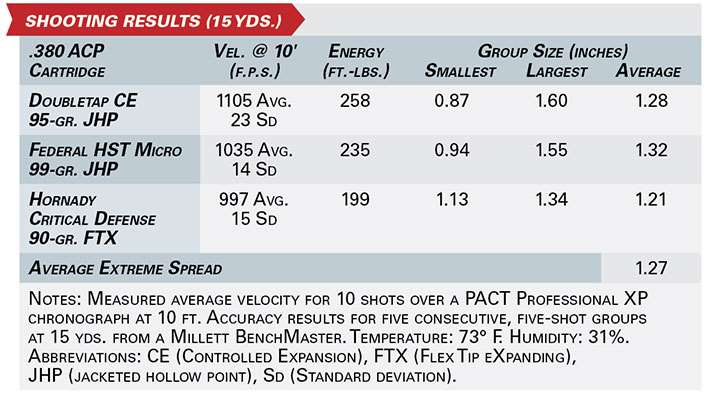
“People ask why we didn’t just downsize our popular XD platform for the .380 cartridge, and it’s because Springfield Armory’s heritage is really with the 1911, and there’s a kindred spirit between that gun and the new 911. A lot of people prefer the styling, and a hammer-fired .380 just seemed like a more natural path for us to follow—and it allows us to produce the 911 here in Geneseo, Illinois.”
That choice appears to have paid off. “Our initial market response to the 911 has been very promising; we’ve had to add on to the facility in order to handle all the demand for the new 911, and have added some new people on as well. It’s been a bonus to the community in terms of hiring more people,” Reese said. “Illinois is pretty much run by Chicago, and there are quite a few folks who don’t care for firearms. But we’re very important to our county, as we’re the largest employers. There are a lot of states who would love to have us, but we’re going to continue to fight and stay in the state of Illinois. This is where we’re from, and we’re very proud of it.”
In my opinion, Springfield Armory has every right to be proud of its newest pistol, having met its goal of building a micro-compact that is comfortable to shoot and pleasant to carry. The new 911 has the reliability and accuracy required to meet the needs of those who have to act as their own first responder.
